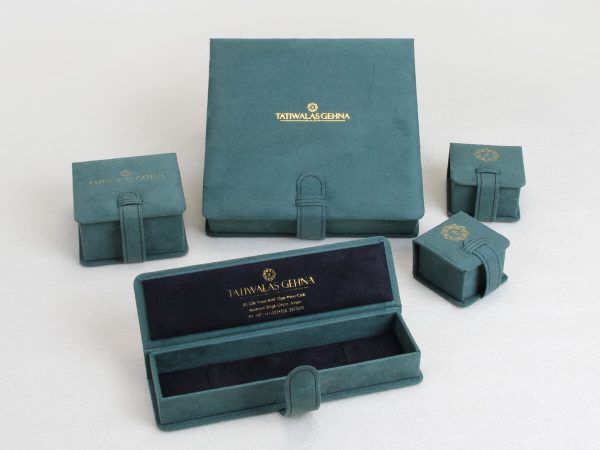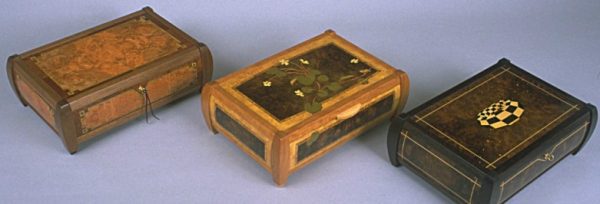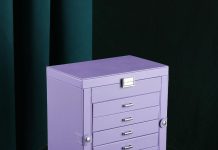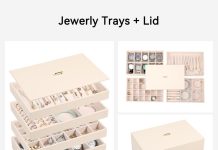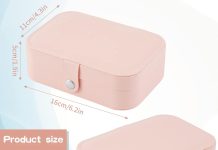If you’ve ever wondered about the materials used to create those beautiful jewelry boxes you see in stores or online, you’re in the right place. From timeless classics to modern designs, jewelry boxes come in all shapes and sizes, but what exactly are they made from? Let’s explore the common materials used in crafting these functional and stylish storage solutions for your beloved baubles.
Review contents
Wood
Wood is one of the most popular materials used for making jewelry boxes. There are several types of wood that are commonly used, each with its own unique characteristics and appeal.
Types of Wood
Some of the most common types of wood used in jewelry box construction include mahogany, oak, cherry, walnut, and maple. Mahogany is known for its rich, deep color and elegant appearance, making it a popular choice for high-end jewelry boxes. Oak is a durable and versatile wood that can be stained to achieve different finishes. Cherry has a warm, reddish hue that adds a touch of sophistication to any jewelry box. Walnut is prized for its deep, dark color and beautiful grain patterns. Lastly, maple is a light-colored wood that can be stained to mimic other types of wood or left in its natural state for a more contemporary look.
Advantages of Wood
One of the main advantages of using wood for jewelry boxes is its durability. Wood is a strong material that can withstand everyday wear and tear, ensuring that your precious jewelry remains safe and protected. Additionally, wood has a timeless and classic appeal that never goes out of style, making it a suitable choice for both traditional and modern designs. It is also worth mentioning that wood is a renewable resource, making it an eco-friendly option for those who are conscious of their environmental impact.
Disadvantages of Wood
While wood has many advantages, there are also a few drawbacks to consider. First, wood can be susceptible to scratching and denting if not properly cared for. Regular maintenance, such as polishing and waxing, is necessary to keep the wood looking its best. Additionally, some types of wood, such as cherry and mahogany, can darken over time, which may alter the appearance of the jewelry box. Finally, wood can be relatively heavy, especially when compared to other materials like plastic or fabric. This can make moving or transporting the jewelry box a bit more challenging.
Cardboard
Cardboard is a lightweight and inexpensive material that is commonly used for making jewelry boxes. It offers several advantages and is a popular choice for those on a budget.
Types of Cardboard
There are two main types of cardboard used in jewelry box construction: corrugated cardboard and paperboard. Corrugated cardboard consists of two flat layers of cardboard with a corrugated sheet sandwiched in between. This type of cardboard is known for its strength and durability. On the other hand, paperboard is a thicker and sturdier variant of regular paper, making it a suitable choice for small to medium-sized jewelry boxes.
Advantages of Cardboard
The main advantage of cardboard jewelry boxes is their affordability. Cardboard is a low-cost material, making it an ideal choice for those looking for budget-friendly storage options for their jewelry. Additionally, cardboard is lightweight, which makes it easy to transport or move around as needed. Cardboard boxes are also customizable, allowing you to add your own personal touch with paints, stickers, or other embellishments.
Disadvantages of Cardboard
Despite its advantages, cardboard does have a few disadvantages. First, it is not as durable as other materials like wood or metal. Cardboard boxes can easily get crushed or damaged over time, especially if not handled with care. Additionally, cardboard is not moisture-resistant, which means it is not suitable for storing jewelry in humid environments. Lastly, cardboard may not have the same aesthetic appeal as other materials like wood or leather, which can be an important factor for those looking for a more visually appealing jewelry box.
Leather
Leather is a luxurious and timeless material that is often associated with high-end jewelry boxes. It offers several unique advantages and is favored by many jewelry enthusiasts.
Types of Leather
There are several types of leather commonly used in the construction of jewelry boxes, including full-grain leather, top-grain leather, and bonded leather. Full-grain leather is the highest quality and most durable type of leather, made from the top layer of the hide. It retains the natural grain and imperfections of the hide, giving it a unique and rustic appearance. Top-grain leather is similar to full-grain leather but has been sanded and buffed to remove any imperfections. Bonded leather, on the other hand, is made from leftover leather scraps that have been reconstituted into a usable material.
Advantages of Leather
One of the main advantages of leather jewelry boxes is their luxurious and sophisticated appearance. Leather has a natural beauty and elegance that adds a touch of class to any setting. Additionally, leather is a durable material that can withstand regular use and is resistant to moisture and stains, making it a suitable choice for storing valuable jewelry. Another advantage of leather is that it develops a unique patina over time, giving it even more character and charm.
Disadvantages of Leather
Despite its advantages, leather does have a few drawbacks. First and foremost, leather jewelry boxes tend to be more expensive than those made from other materials like wood or plastic. The cost of the material and the craftsmanship involved in working with leather contribute to the higher price tag. Additionally, leather requires regular maintenance to keep it looking its best. It should be conditioned and protected from excessive moisture to prevent cracking or discoloration. Lastly, some people may have ethical concerns regarding the sourcing and production of leather, as it is derived from animal hides.
Metal
Metal jewelry boxes are known for their sleek and modern appearance. They offer a unique set of advantages and are a popular choice for those looking for a contemporary storage solution.
Types of Metal
There are several types of metal commonly used in the construction of jewelry boxes, including stainless steel, brass, silver, and gold. Stainless steel is a highly durable and corrosion-resistant metal that is often used in minimalist and industrial-style jewelry boxes. Brass, on the other hand, has a warm and rich appearance, making it a popular choice for vintage or antique-inspired designs. Silver and gold jewelry boxes are usually reserved for luxury collections, as these precious metals have a high value and signify elegance and opulence.
Advantages of Metal
One of the main advantages of metal jewelry boxes is their durability. Metals are known for their strength and can withstand regular wear and tear without losing their shape or structural integrity. Metal boxes are also resistant to moisture and staining, providing a safe and secure environment for your valuable jewelry. Another advantage of metal is its modern and sleek appearance. Metal boxes often feature clean lines and minimalist designs, making them a visually appealing choice for those with a contemporary aesthetic.
Disadvantages of Metal
Despite their advantages, metal jewelry boxes do have a few disadvantages to consider. First, metal can be quite heavy, especially if constructed from solid steel or brass. This can make the jewelry box bulky and less portable, which may be a drawback for those who travel frequently. Additionally, metal surfaces can scratch easily, especially if not properly maintained. Regular cleaning and polishing are necessary to keep the metal looking its best. Finally, metal boxes tend to be more expensive than those made from other materials like wood or plastic, primarily due to the cost of the material itself and the craftsmanship involved.
Plastic
Plastic is a versatile and affordable material that is commonly used in the production of jewelry boxes. It offers several advantages and is a popular choice for those seeking a lightweight and cost-efficient storage solution.
Types of Plastic
There are many types of plastic used in jewelry box construction, including acrylic, polypropylene, and ABS plastic. Acrylic is a transparent and lightweight plastic that is often used to create clear jewelry boxes, allowing you to easily see and display your jewelry. Polypropylene is a durable and flexible plastic that can be molded into various shapes and sizes, making it a versatile option for jewelry box designs. Lastly, ABS plastic is a strong and impact-resistant material often used in jewelry boxes that require extra protection, such as travel cases.
Advantages of Plastic
One of the main advantages of plastic jewelry boxes is their affordability. Plastic is a low-cost material, making it an ideal choice for those on a budget. Plastic boxes are also lightweight, which makes them easy to transport or move around as needed. Additionally, plastic is resistant to moisture and staining, providing a safe and secure environment for your jewelry. Plastic boxes are also available in a wide range of colors, shapes, and sizes, allowing you to find the perfect box to suit your personal style and needs.
Disadvantages of Plastic
Despite their advantages, plastic jewelry boxes do have a few drawbacks. First, plastic is not as durable as materials like wood or metal and can be prone to scratching, cracking, or warping with regular use. If not handled with care, plastic boxes can easily get damaged, compromising their functionality and appearance. Additionally, plastic can be less visually appealing compared to other materials like wood or leather. Some people may prefer the natural beauty and elegance of other materials over the synthetic look of plastic. Lastly, plastic is not an environmentally friendly material, as it is derived from fossil fuels and can take a long time to decompose.
Glass
Glass jewelry boxes are known for their elegant and sophisticated appearance. They offer a unique set of advantages and are a popular choice for those who appreciate the beauty of transparency.
Types of Glass
There are several types of glass used in the construction of jewelry boxes, including clear glass, stained glass, and frosted glass. Clear glass jewelry boxes are designed to showcase your jewelry in all its glory, allowing you to easily see and admire your collection. Stained glass boxes, on the other hand, feature vibrant colored glass panes that add a touch of artistic flair to the design. Frosted glass is a type of glass that has been chemically treated to create a translucent and matte finish, offering a more subtle and modern look.
Advantages of Glass
One of the main advantages of glass jewelry boxes is their aesthetic appeal. Glass has a timeless beauty and elegance that adds a touch of sophistication to any space. Glass boxes are perfect for displaying your jewelry collection, allowing you to showcase your prized pieces in a classy and stylish manner. Additionally, glass is a durable and easy-to-clean material that is resistant to moisture and staining, ensuring that your jewelry remains safe and protected.
Disadvantages of Glass
Despite their advantages, glass jewelry boxes do have a few disadvantages to consider. First, glass can be quite fragile and can shatter if dropped or mishandled. This makes glass boxes less suitable for travel or for those with active lifestyles. Additionally, glass can be heavy, especially if the jewelry box is made with thick or layered glass. This can make the box less portable and more difficult to move around. Lastly, glass boxes can be more expensive than those made from other materials like wood or plastic. The cost of the glass itself and the craftsmanship involved in working with glass contribute to the higher price tag.
Fabric
Fabric jewelry boxes offer a soft and elegant storage solution. They come in various styles and designs, making them a popular choice for those looking for a decorative and functional jewelry box.
Types of Fabric
There are many types of fabric commonly used in the construction of jewelry boxes, including velvet, silk, satin, and cotton. Velvet is a luxurious and soft fabric that is often used for lining the interior of jewelry boxes, providing a cushioned and protective surface for your precious pieces. Silk and satin are lightweight and smooth fabrics that add a touch of elegance and sophistication to the exterior of the box. Cotton is a versatile fabric that can be used for both the exterior and interior of the box, offering a more casual and understated look.
Advantages of Fabric
One of the main advantages of fabric jewelry boxes is their soft and gentle nature. Fabrics like velvet provide a cushioned and protective environment for your jewelry, preventing scratches and damage. Additionally, fabric boxes are lightweight and easy to transport or move around as needed. Fabric boxes are also available in a wide range of colors, patterns, and designs, allowing you to find the perfect box to suit your personal style and decor. Finally, fabric boxes are often more budget-friendly compared to other materials like wood or leather, making them a suitable choice for those on a budget.
Disadvantages of Fabric
Despite their advantages, fabric jewelry boxes do have a few drawbacks. First, fabric can be prone to staining and absorbing odors, especially if not properly cared for. It is important to keep fabric boxes clean and dry to prevent any discoloration or odor buildup. Additionally, fabric boxes may not be as durable as other materials like wood or metal and can be prone to wear and tear over time. Finally, fabric boxes may not offer the same level of security and protection as boxes made from materials like metal or wood. If you have valuable or delicate jewelry, you may prefer a more secure storage option.
Acrylic
Acrylic jewelry boxes offer a modern and sleek storage solution. They are lightweight, durable, and visually appealing, making them a popular choice for those seeking a contemporary and minimalist design.
Types of Acrylic
There are several types of acrylic used in the construction of jewelry boxes, including clear acrylic, colored acrylic, and mirrored acrylic. Clear acrylic boxes are designed to showcase your jewelry collection in a transparent and elegant manner. Colored acrylic boxes, on the other hand, come in a variety of vibrant hues, allowing you to add a pop of color to your space. Mirrored acrylic boxes feature a reflective surface, adding a touch of glamour and sophistication to the design.
Advantages of Acrylic
One of the main advantages of acrylic jewelry boxes is their visual appeal. Acrylic has a modern and sleek appearance that adds a contemporary touch to any setting. Additionally, acrylic is a lightweight material that is easy to transport or move around as needed. Acrylic boxes are also durable and impact-resistant, making them a suitable choice for those with an active lifestyle or for travel. Another advantage of acrylic is its ease of cleaning and maintenance. Acrylic boxes can be wiped clean with a soft cloth, ensuring that your jewelry remains in a pristine condition.
Disadvantages of Acrylic
Despite their advantages, acrylic jewelry boxes do have a few disadvantages to consider. First and foremost, acrylic can easily scratch or crack if not handled with care. It is important to place your acrylic box on a soft surface and to avoid using abrasive cleaning materials to prevent any damage. Additionally, acrylic can be prone to discoloration over time, especially when exposed to direct sunlight or harsh chemicals. Lastly, acrylic boxes may not have the same level of visual appeal as other materials like wood or leather. Some people may prefer the warmth and richness of natural materials over the synthetic look of acrylic.
Ceramic
Ceramic jewelry boxes offer a unique and artistic storage solution. They come in various shapes, sizes, and designs, making them a popular choice for those seeking a one-of-a-kind storage option.
Types of Ceramic
There are many types of ceramic used in the construction of jewelry boxes, including earthenware, stoneware, and porcelain. Earthenware is a low-fired ceramic that is known for its rustic appearance and porous nature. Stoneware, on the other hand, is a high-fired ceramic that is dense and durable. Porcelain is a translucent and delicate ceramic that is often used for more delicate and intricate designs.
Advantages of Ceramic
One of the main advantages of ceramic jewelry boxes is their artistic appeal. Ceramic boxes are often handcrafted and feature intricate details and designs, making them a unique and decorative addition to any space. Additionally, ceramic is a durable and long-lasting material that can withstand regular use without losing its shape or color. Ceramic boxes are also easy to clean and maintain, requiring just a gentle wipe to remove any dust or dirt.
Disadvantages of Ceramic
Despite their advantages, ceramic jewelry boxes do have a few disadvantages to consider. First, ceramic can be quite fragile and can break if dropped or mishandled. This makes ceramic boxes less suitable for travel or for those with children or pets. Additionally, ceramic boxes can be quite heavy, especially if they are large or have intricate designs. This can make the box more difficult to move or transport. Lastly, ceramic boxes tend to be more expensive compared to those made from other materials like wood or fabric. The cost of the material itself and the craftsmanship involved in working with ceramic contribute to the higher price tag.
Resin
Resin jewelry boxes offer a unique and versatile storage solution. They come in various shapes, colors, and designs, making them a popular choice for those seeking a customizable and artistic storage option.
Types of Resin
There are several types of resin used in the construction of jewelry boxes, including epoxy resin, polyurethane resin, and polyester resin. Epoxy resin is a clear and glossy material that is often used to create a smooth and glass-like finish. Polyurethane resin is a strong and durable material that can be pigmented to achieve various colors and effects. Polyester resin is a flexible and lightweight material that is often used for jewelry box designs that require intricate details and designs.
Advantages of Resin
One of the main advantages of resin jewelry boxes is their versatility. Resin can be molded and shaped into various forms, allowing for a wide range of creative designs and styles. Additionally, resin boxes can be customized with pigments, glitter, or other embellishments, allowing you to create a truly unique and personalized storage option. Resin boxes are also durable and long-lasting, able to withstand regular use without losing their shape or color. Lastly, resin is a lightweight material, making the box easy to transport or move around as needed.
Disadvantages of Resin
Despite their advantages, resin jewelry boxes do have a few disadvantages to consider. First, resin can be susceptible to scratching or scuffing if not handled with care. It is important to place your resin box on a soft surface and to avoid using abrasive or harsh cleaning materials. Additionally, resin boxes may not have the same level of visual appeal as boxes made from other materials like wood or metal. Some people may prefer the natural beauty and elegance of other materials over the synthetic look of resin. Lastly, resin boxes can be more expensive compared to those made from other materials like plastic or fabric. The cost of the material itself and the craftsmanship involved in working with resin contribute to the higher price tag.
In conclusion, jewelry boxes can be made from a wide variety of materials, each with its own unique advantages and disadvantages. Wood offers timeless beauty and durability, while cardboard provides an affordable and lightweight option. Leather exudes luxury and sophistication, while metal offers a sleek and modern appearance. Plastic is versatile and cost-effective, glass adds elegance and transparency, and fabric offers a soft and customizable storage solution. Acrylic provides a contemporary and minimalist design, ceramic offers artistic charm, and resin allows for personalized and unique creations. Ultimately, the choice of material for a jewelry box depends on personal preferences, budget, and the desired aesthetic.



